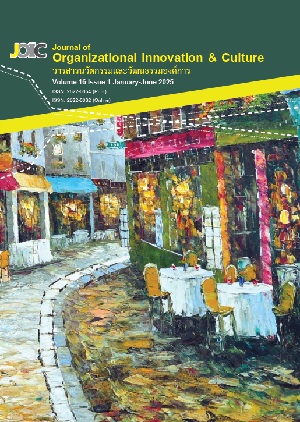Needs in Using Online Learning Resources Regarding Arts and Culture in Southern Thailand and the Malay Peninsula of the Students in the Three MOU Universities
Keywords:
Need, Online Learning Resources, Arts and Culture in Southern Thailand and the Malay PeninsulaAbstract
This research aims to investigate and compare the needs regarding types, knowledge information, and characteristics of online learning media related to arts and culture in the South and the Siam-Malay Peninsula among students within the MOU network of three universities. The research methodology was divided into two parts: 1) Quantitative Research: Data was collected from a sample group comprising the undergraduate students at Prince of Songkla University Hat Yai Campus, Thaksin University Songkhla Campus, and Rajamangala University of Technology Srivijaya Songkhla Campus, with a total of 395 students. The sample size was determined using the Yamane Formula and selected through the Proportionate Stratified Random Sampling to ensure representation according to the population size within each category. Subsequently, the Simple Random Sampling was applied, where the students were selected without replacement until the specified sample size was achieved. Data was collected using a questionnaire, with subsequent analysis employing frequency distribution, percentage, mean, and standard deviation. The study also compared the students’ needs for online learning media, across different categories including universities, genders, and year levels, by applying the F-values in a one-way analysis of variance. When statistically significant differences were detected at the .05 level, pairwise comparisons were conducted using the LSD method. 2) Qualitative Research: Data collection was performed with a sample group of 15 students from the MOU network of the aforementioned three universities. These participants were purposively selected from those with experience in using online learning media on the website NAAMCHOOP.COM, who consented to provide additional information via individual interviews within the questionnaire. The Simple Random Sampling method was employed using a non-replacement lottery approach for each university, until a group of five performants from each institution was achieved Semi-structured interviews were used as the data collection instrument, and the collected data was analyzed using content analysis techniques.
The finding revealed that: 1) students exhibited a strong desire to utilize online learning media focusing on arts and culture in the South and the Siam-Malay Peninsula, showing a strong need across all aspects with the highest demand for the characteristics of online learning media. 2) When comparing the level of need for media use across different universities, students from Thaksin University, Songkhla Campus, demonstrated the highest need. Moreover, it was found that students in different universities and with different genders had significantly different needs. When considering needs in specific aspects, the students were found to have significantly different needs regarding types of media and knowledge but no significant difference was found in their needs of online learning media characteristics. The findings revealed students’ needs of knowledge about traditions and rituals, with a preference for social media platforms that are accessible at all times with multilingual options. These findings serve as valuable insights for developing media plans, particularly for publication on the Naamchoop.com website operated by the Self-Access Learning Center of the Faculty of Liberal Arts at Prince of Songkla University, guiding future initiatives.
References
Chamnian, M., Chamnian, K., & Boonkwan, S. (2022). Guideline for promoting lifelong learning about arts, culture and wisdom of educational institutes. Ratchaphruek Journal, 17(3), 112–121. https://www.tcithaijo.org/index.php/Ratchaphruekjournal/article/download/205411/154183
Faculty of Liberal Arts, Prince of Songkla University. (2021). Strategic plan for the Faculty of Liberal Arts, B.E. 2562–2564 (2019–2021). Prince of Songkla University. https://drive.google.com/file/d/11EWMO00aEHBUrvpB7zT8nIW5LW80fGaP/view
Geith, C. (2008). Access to education with online learning and open educational resources: Can they close the gap?. Journal of Asynchronous Learning Networks, 12(1), 105–126. https://files.eric.ed.gov/fulltext/EJ837472.pdf
Karnthai, D. (2016, August 8). Thailand – Ceremonies and rituals. https://www.sac.or.th/databases/southeastasia/subject.php?c_id=9&sj_id=79
Khmdee, K. (2021). Innovative teaching and learning management with mobile technology via online application. Journal of MCU Loei Review, 2(3), 35–49. https://so05.tci-thaijo.org/index.php/MCUL/article/view/257198/173551
Klimova, B. (2017). Students´ preferences for learning materials in technology-enhanced higher education. New Trends and Issues Proceedings on Humanities and Social Sciences, 2(11), 20–28. https://doi.org/10.18844/prosoc.v2i11.1900
Kongmanus, K. (2018). Digital learning tools: Ways of digital education era. Journal of Education and Innovation, 20(4), 279–290. https://so06.tci-thaijo.org/index.php/edujournal_nu/article/view/122056/107771
Kuenui, P. (2022). Social media use behavior and media literacy among students in Changlangprachacukul School Nakhon Si Thammarat Province. Journal of MCU Nakhondhat, 9(6), 198–211. https://so03.tci-thaijo.org/index.php/JMND/article/download/262070/174398/982729
Lertbumroongchai, K. (2020, November 12). Learning media technique in digital age V.2. TouchPoint.in.th. https://touchpoint.in.th/learning-media-technique-in-digital-age-v2/
Mosin, P., Thongdee, L., Lasomboon, A., & Akkaranet, K. (2016). Creating online teaching media using creative theory in Thailand 4.0. Journal of Pacific Institute of Management Science, 2(2), 161–171. https://so05.tci-thaijo.org/index.php/pacific/article/download/203652/142035/626555
Porncharoen, R., & Peerawanichkul, U. (2017). Learning media needs in education digital age of Rajamangala University of Technology Phra Nakhon [Research report]. Rajamangala University of Technology Phra Nakhon. http://repository.rmutp.ac.th/handle/123456789/2700
Prasoetsi, J., & Liamthaisong, K. (2014). Development of the local arts and culture multimedia for Buri Ram juvenile. Rommayasan, 12(1), 43–45. https://dspace.bru.ac.th/xmlui/bitstream/handle/123456789/1229/12_1_2557_Chirayut_Prasoetsi.pdf?sequence=1&isAllowed=y
Prince of Songkla University. (2023, October 27). Strategic plan for the development of Prince of Songkla University, B.E. 2566-2570 (2023-2027). https://planning.psu.ac.th/documents/information/planning/plan66-70.pdf
Saikhueankhan, S. (2013). Social network using behavior of students at Rajabhat Nakornpathom University [Master's degree thesis, Silpakorn University]. https://sure.su.ac.th/xmlui/bitstream/handle/123456789/12435/fulltext.pdf?sequence=2&isAllowed=y
Senawong N. (2021). A study of behavior for using of social media of Generation Z in the new normal era in Bangkok [Master’s independent study, Siam University]. https://e-research.siam.edu/kb/a-study-of-behavior-for-using-of-social-media/
TOT Public Company Limited. (2020, January 19). 5 Learning media for the modern age: Which media should you learn from? https://www.tot.co.th/sme-tips/SME-tips/2020/06/19/5
Vattanakanlayakul, P. (2018). A study of communication behaviors, uses and gratifications by using social media to create the network of Morlum fanclub: A case study of Facebook fan page “Theph-Lai” [Master's degree thesis, Rajamangala University of Technology Thanyaburi]. http://www.repository.rmutt.ac.th/dspace/handle/123456789/3375
Yamane, T. (1970). Statistic: An introductory analysis (2nd ed.). Harper & Row.
Downloads
Published
Issue
Section
License
Copyright (c) 2025 Journal of Organizational Innovation & Culture

This work is licensed under a Creative Commons Attribution-NoDerivatives 4.0 International License.





